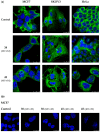Microtubule Destabilizing Sulfonamides as an Alternative to Taxane-Based Chemotherapy
- PMID: 33673002
- PMCID: PMC7918738
- DOI: 10.3390/ijms22041907
Microtubule Destabilizing Sulfonamides as an Alternative to Taxane-Based Chemotherapy
Abstract
Pan-Gyn cancers entail 1 in 5 cancer cases worldwide, breast cancer being the most commonly diagnosed and responsible for most cancer deaths in women. The high incidence and mortality of these malignancies, together with the handicaps of taxanes-first-line treatments-turn the development of alternative therapeutics into an urgency. Taxanes exhibit low water solubility that require formulations that involve side effects. These drugs are often associated with dose-limiting toxicities and with the appearance of multi-drug resistance (MDR). Here, we propose targeting tubulin with compounds directed to the colchicine site, as their smaller size offer pharmacokinetic advantages and make them less prone to MDR efflux. We have prepared 52 new Microtubule Destabilizing Sulfonamides (MDS) that mostly avoid MDR-mediated resistance and with improved aqueous solubility. The most potent compounds, N-methyl-N-(3,4,5-trimethoxyphenyl-4-methylaminobenzenesulfonamide 38, N-methyl-N-(3,4,5-trimethoxyphenyl-4-methoxy-3-aminobenzenesulfonamide 42, and N-benzyl-N-(3,4,5-trimethoxyphenyl-4-methoxy-3-aminobenzenesulfonamide 45 show nanomolar antiproliferative potencies against ovarian, breast, and cervix carcinoma cells, similar or even better than paclitaxel. Compounds behave as tubulin-binding agents, causing an evident disruption of the microtubule network, in vitro Tubulin Polymerization Inhibition (TPI), and mitotic catastrophe followed by apoptosis. Our results suggest that these novel MDS may be promising alternatives to taxane-based chemotherapy in chemoresistant Pan-Gyn cancers.
Keywords: antitumor; breast cancer; combretastatin A-4; gynecologic cancer; sulfonamide; taxane; tubulin.
Conflict of interest statement
The authors declare no conflict of interest.
Figures





Similar articles
-
A semisynthetic taxane Yg-3-46a effectively evades P-glycoprotein and β-III tubulin mediated tumor drug resistance in vitro.Cancer Lett. 2013 Dec 1;341(2):214-23. doi: 10.1016/j.canlet.2013.08.010. Epub 2013 Aug 11. Cancer Lett. 2013. PMID: 23941826
-
New indolesulfonamide derivatives targeting the colchicine site of tubulin: synthesis, anti-tumour activity, structure-activity relationships, and molecular modelling.J Enzyme Inhib Med Chem. 2021 Dec;36(1):2025-2044. doi: 10.1080/14756366.2021.1975277. J Enzyme Inhib Med Chem. 2021. PMID: 34514909 Free PMC article.
-
Orally bioavailable tubulin antagonists for paclitaxel-refractory cancer.Pharm Res. 2012 Nov;29(11):3053-63. doi: 10.1007/s11095-012-0814-5. Epub 2012 Jul 4. Pharm Res. 2012. PMID: 22760659 Free PMC article.
-
Taxane- and epothilone-based chemotherapy: from molecule cargo cytoskeletal logistics to management of castration-resistant prostate carcinoma.Eur Rev Med Pharmacol Sci. 2013 Jun;17(12):1658-64. Eur Rev Med Pharmacol Sci. 2013. PMID: 23832735 Review.
-
Therapeutic strategies to overcome taxane resistance in cancer.Drug Resist Updat. 2021 Mar;55:100754. doi: 10.1016/j.drup.2021.100754. Epub 2021 Feb 27. Drug Resist Updat. 2021. PMID: 33691261 Review.
Cited by
-
Kojic Acid Derivative as an Antimitotic Agent That Selectively Kills Tumour Cells.Pharmaceuticals (Basel). 2024 Dec 25;18(1):11. doi: 10.3390/ph18010011. Pharmaceuticals (Basel). 2024. PMID: 39861074 Free PMC article.
-
Panobinostat Synergistically Enhances the Cytotoxicity of Microtubule Destabilizing Drugs in Ovarian Cancer Cells.Int J Mol Sci. 2022 Oct 27;23(21):13019. doi: 10.3390/ijms232113019. Int J Mol Sci. 2022. PMID: 36361809 Free PMC article.
-
Potent and Selective Benzothiazole-Based Antimitotics with Improved Water Solubility: Design, Synthesis, and Evaluation as Novel Anticancer Agents.Pharmaceutics. 2023 Jun 9;15(6):1698. doi: 10.3390/pharmaceutics15061698. Pharmaceutics. 2023. PMID: 37376146 Free PMC article.
-
Methoxy and bromo scans on N-(5-methoxyphenyl) methoxybenzenesulphonamides reveal potent cytotoxic compounds, especially against the human breast adenocarcinoma MCF7 cell line.J Enzyme Inhib Med Chem. 2021 Dec;36(1):1029-1047. doi: 10.1080/14756366.2021.1925265. J Enzyme Inhib Med Chem. 2021. PMID: 34107837 Free PMC article.
-
Novel sulfonamides unveiled as potent anti-lung cancer agents via tumor pyruvate kinase M2 activation.RSC Med Chem. 2024 Jul 11;15(9):3070-3091. doi: 10.1039/d4md00367e. eCollection 2024 Sep 19. RSC Med Chem. 2024. PMID: 39309364 Free PMC article.
References
-
- Hoadley K.A., Yau C., Hinoue T., Wolf D.M., Lazar A.J., Drill E., Shen R., Taylor A.M., Cherniack A.D., Thorsson V., et al. Cell-of-Origin Patterns Dominate the Molecular Classification of 10,000 Tumors from 33 Types of Cancer. Cell. 2018;173:291–304.e6. doi: 10.1016/j.cell.2018.03.022. - DOI - PMC - PubMed
-
- Gonzalez-Angulo A.M., Morales-Vasquez F., Hortobagyi G.N. Breast Cancer Chemosensitivity. Springer; Berlin/Heidelberg, Germany: 2013. Overview of Resistance to Systemic Therapy in Patients with Breast Cancer. Madame Curie Biosci. Database. - PubMed
MeSH terms
Substances
Grants and funding
- SA030U16, SA262P18 and SA116P20/Consejería de Educación de la Junta de Castilla y León, co-funded by the EU's European Regional Development Fund-FEDER
- RTI2018-099474-BI00/Spanish Ministry of Science, Innovation and Universities
- PI16/01920 and PI20/01569/health research program of the Instituto de Salud Carlos III (Spanish Ministry of Economy and Competitiveness) co-funded with FEDER founds.
LinkOut - more resources
Full Text Sources
Other Literature Sources
Research Materials
Miscellaneous

